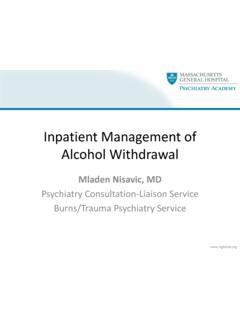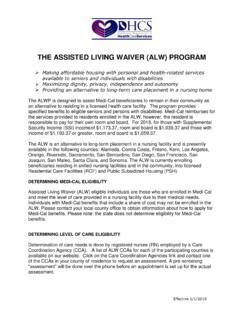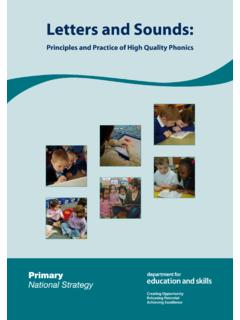Transcription of Cognitive Behavioral Therapy (CBT) for Substance Use Disorder
1 Behavioral Therapy (CBT) for Substance Use DisorderJohn F. Kelly, Neither I nor my spouse/partner has a relevant financial relationship with a commercial interest to is CBT and its assumptions?What are the clinical strategies involved in CBT? How effective is CBT as an intervention for SUD?How does it work? Some Behavioral Therapy (CBT) is CBT and its assumptions?What are the clinical strategies involved in CBT? _____How effective is CBT as an intervention for SUD?How does it work?Some Behavioral Therapy (CBT) Quitting smoking is easy, I ve done it dozens of times Mark Model9 ThoughtsFeelingsBehaviorsTheory Key process mechanisms Substance use Recovery Social Control Lack of strong bonds with family, friends, work, religion, other aspects traditional society Goal-direction, structure and monitoring, shaping behavior to adaptive social bonds Social Learning Modeling and observation and imitation of Substance use, social reinforcement for and expectations of positive consequences from use.
2 Positive norms for use Social network composed of individuals who espouse abstinence, reinforce negative expectations about effects of substances, provide models of effective sober living Stress and coping life stressors ( , social/work/financial problems, phys/sex abuse) lead to Substance use especially those lacking coping and avoid problems; Substance use form of avoidance coping, self-medication Effective coping enhances self-confidence and self-esteem Behavioral economics Lack of alternative rewards provided by activities other than Substance use Effective access to alternative, competing, rewards through involvement in educational, work, religious, social/recreational pursuits Source.
3 Adapted from Moos, RH (2011) Processes the promote recovery from addictive psychosocial theories for Based on social- Cognitive learning theory Substance use functionally related to major life problems Coping deficits ( , life stress, Substance -related cues) maintain use/relapse Coping skills training addresses and overcomes skill deficits Enhance identification and coping with high-risk situations/cues Increase active adaptive Behavioral - Cognitive coping Enhance sobriety-based social support11 What is CBT for SUD? addresses two major types of learning that contribute to by Association Classical ConditioningLearning by Consequence Operant Conditioning Neutral stimuli become triggers for Substance use/cravings, through repeated associations between stimuli and drug (conditioning).
4 Externaltriggers: People, places, time of day, day of week, Internaltriggers:thoughts, emotions, pain/physiological changes Substance use is shaped by the consequences of use. Positive Reinforcement: if after using a Substance a person feels more comfortable in social situations or happier etc. Negative Reinforcement: if Substance use reduces anxiety, tension, stress, or depression; future use to reduce or terminate the unpleasant experience( , spraying a cat with waterFor jumping on the kitchen counter) Assumption: Substance problems arise/continue due to deficits in sober coping is motivated to stop/reduce Substance use-needs to acquire skills to do to engage in active coping when encountering precipitants to Substance use contributes to is differentially effective in increasing active coping efforts when compared to alternative problems with coping are attributable to skills deficits, performance-based skill training techniquesare necessary to remediate deficitsAssumptions of is CBT and its assumptions?
5 What are the clinical strategies involved in CBT? How effective is CBT as an intervention for SUD?Does it work the way we think it does?Some Behavioral Therapy (CBT) Establish good therapeutic relationship Educate patients: model, Disorder , Therapy Assess illness objectively, set goals Use evidence to guide treatment decisions (collaborative empiricism) Structure treatment sessions with agenda Limit treatment length Issue and review homework to generalize learning16 Common Components of social- Cognitive learning framework Substance use becomes predominant coping response to triggers ( functional analysis ) , environmental, Cognitive , Skills , problem solving, environmental restructuring, social-interpersonal skills, Cognitive restructuring, coping with craving/urges, control developing support systems Change positive expectancies about effects of use, access alternative reinforcers Develop social systems to support and reinforce relapse risk (Abstinence Violation Effect)Major Goals of InducedStress InducedSubstance InducedSocialPsychNeuro-biologyCBTC ommon Precursors to Relapse and How CBT might helpKelly JF, Yeterian, JD, (2013).
6 In McCradyand Epstein. Comprehensive Textbook on Substance Abuse. ConsequencesNegative ConsequencesModel for CBT Treatment (behavior chain): Functional analysis of Substance use Chain Modifying WorksheetExample11:45 PM and in bed and not asleep I need alcohol to get to sleep"AnxietyDrink alcoholDrowsySleepWake up early;jittery; worriedTriggerThoughtsFeelingsBehaviorPo sitive ConsequencesNegative is CBT and its assumptions?What are the clinical strategies involved in CBT? How effective is CBT as an intervention for SUD?Does it work the way we think it does?Some Behavioral Therapy (CBT) Meta-analysisof 53 controlled trials (1982-2006) of CBT for adults with alcohol-or drug-use disorders.
7 Findings demonstrate utility ofCBTacross a large and diverse sample of studies and under rigorous conditions for establishing Treatment Effect Small but statistically significant treatment effect (g = , p < .005) Effects diminished over time:6-to 9-months (g = , p < .005)12 months (g = , p < .05)Subgroup Moderators Across substances, strongest among marijuana users(g = , p < .005) CBT combined with additional psychosocial treatment (g = , p < .005; n = 19)had a larger effect size than CBT combined with pharmacological treatment (g = , p < .005; n =13) and CBT alone (g = , p < .05; n = 21) Large effect size for CBT compared to no treatment (g = , p < .005; n = 6)Regression Moderators Women appeared to benefit more from CBT than men (b =.)
8 005, p < .05) Benefit of shorter duration interventions: length of treatment had a negative association (b = , p < .005) with effect size No difference in effectiveness by format (group or individual) Little evidence for its value as an adjunctive treatment particularly in combination with contingency managementHow effective is CBT as an intervention for SUD?Magill M, & Ray, LA. (2009). Cognitive - Behavioral treatment with adult alcohol and illicit drug users: ameta-analysisof randomized controlled trials. J Stud Alcohol Drugs, 70(4): is CBT and its assumptions?What are the clinical strategies involved in CBT? _____How effective is CBT as an intervention for SUD?How does it work?Some Behavioral Therapy (CBT) Skills MediatorDrinking-related outcomeCBT vs.
9 ComparisonHypothesis: CBT for SUD works through increasing Cognitive and Behavioral coping skillsReview of 10 studies involving random assignment of participants to treatment condition (CBT and at least one comparison condition)Four necessary conditions to establish support for coping skills reduces Substance use more than increases coping skill mediator more than outcome co-varies with coping skills mediator as a covariate reduces the treatment effectExamining evidence of CBT s hypothesized mechanisms of actionMorgenstern, J. and Longabaugh, R. (2000). Cognitive Behavioral treatment for alcohol dependence: A review of evidence for its hypothesized mechanisms of action. Addiction, 95: 1475 1490.
10 Skills MediatorDrinking-related outcomeCBT vs. ComparisonResults indicate little support for the hypothesized mechanisms of action of CBT. Overall no reported positive findings Most common that none or only one step of the mediational chain supportedResearch has not yet established whyCBT is an effective treatment for explanations for negative findings: Methodological flaws of prior studies may have obscured detection of effects One or more underlying assumptions of CBT model may require revisionExamining evidence of CBT s hypothesized mechanisms of actionMorgenstern, J. and Longabaugh, R. (2000). Cognitive Behavioral treatment for alcohol dependence: A review of evidence for its hypothesized mechanisms of action.









